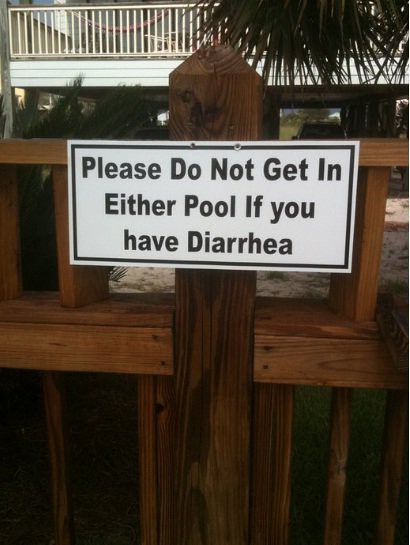Public pools have always grossed us out. But the fact that this “diarrhea warning” sign even exists is disturbing. There was obviously some kind of reoccurring problem that justified the creation of this diarrhea sign. Kind of gives new meaning to “doing a cannonball” off the diving board.
Table of Contents[Hide][Show]

Are Public Swimming Pools Safe?
339 million Americans visit public pools every year. Besides floating pieces of diarrhea, is it even safe to swim in your local public pool? That depends if your pool adheres to the Model Aquatic Health Code. This code of voluntary recommendations is based on science and best practices with the goal to make water activities healthier and safer. It was produced by the Centers for Disease Control (CDC) and the National Swimming Pool Foundation. But it’s a “voluntary” code and aquatic facilities are not required to follow it.
Diseases You Can Get From A Public Swimming Pool
If your local pool doesn’t follow the code, here are some of the diseases that you could get from your local swimming pool.
- Cryptosporidiosis Parasite: “Crypto” is no fun. Typical systems included diarrhea for 1-2 weeks. In 2010, “Cryptosporidium” parasite levels reached record levels in public pools and hot tubs due to a resistance to chlorine disinfection. The parasite has a protective outer shell that makes it tolerant to chlorine disinfection and allows it to survive outside the body for long periods of time. Alternative disinfection systems, like ultraviolet light and showering before and after your time in the pool have been effective.
- Legionnaires’ Disease: This bacteria-based lung disease is linked to swimming pools and to the moisture created in enclosed indoor public pools. That’s right, you don’t even have to get in the water to get Legionnaires’ Disease. Transmission occurs through breathing in the bacteria-infected water vapors.
- Influenza, Swine, & H1N1 Flu Viruses: Pools with improper chlorine levels can create a moist environment for flu viruses. Infection typically spreads from either personal contact or from touching an infected surface like a pool chair. Avoid touching your eyes and mouth to minimize your risk while at a public aquatic facility.
- Athlete’s Foot: This fungal growth spreads when pieces of infected skin fall from swimmers’ feet. Athlete’s foot is highly contagious and can spread to anywhere on your skin. Dry your skin, especially your feet, immediately and thoroughly after exiting the pool. In other words, don’t put socks on wet feet. Wearing flip-flops while walking around the pool area also helps discourage infection.
Via Amy Vernon (The Bacon Queen)

Frank Wilson is a retired teacher with over 30 years of combined experience in the education, small business technology, and real estate business. He now blogs as a hobby and spends most days tinkering with old computers. Wilson is passionate about tech, enjoys fishing, and loves drinking beer.






















 Bagel Heads: A Strange New Body Modification Trend in Japan
Bagel Heads: A Strange New Body Modification Trend in Japan
Leave a Reply
You must be logged in to post a comment.